The Undeshwar Temple is part of the Bijolia group of temples, situated behind the Mahakal Temple and overlooking the Mandakini Kund in the complex. Dedicated to Shiva, the temple houses a subterranean Shiva linga (aniconic representation of Shiva) in the garbhagriha (sanctum sanctorum), earning it the name Undeshwar.
The temple exemplifies the Bhumija style of temple architecture. One of the distinctive features of the Bhumija temple is that it appears to be born from the earth. These temples are uniquely built not only on a square plan but also on a stellate (star-shaped) plan. Another distinct feature is the shikhara (superstructure), which has four latas (central offsets) on the four cardinal directions, flanked by vertical rows of miniature kutastambhas (pillars topped by miniature shikharas) of decreasing height in the four quadrants.
The west-facing Undeshwar Temple shows a stellate shape. The architectural components include a mukhamandapa (front porch), a mandapa (pillared hall) with enclosed lateral extensions, an antarala (vestibule) and a garbhagriha. Elevated on a lofty vedibandha (basal mouldings) adorned with intricate motifs and deities, the temple showcases exquisite craftsmanship. The jangha (wall) is adorned with depictions of gods, goddesses and celestial maidens. The shikhara of the temple, with its nine storeys, is as intricately designed as the jangha.
The Bhumija style of temple architecture is elaborately discussed in ancient architectural treatises such as the Samaraṅgaṇasutradhara of Bhojadeva and the Aparajitaprccha of Bhuvanadeva. Both texts describe the stellate plan. A temple with a stellate plan and nine storeys, like the Undeshwar Temple, is referred to in these treatises as Sarvangasundara Prasad.
This photo essay highlights the most exquisite feature of the Undeshwar Temple: its intricately carved jangha. The jangha features divine figures, including significant and minor deities, surasundaris (celestial damsels), musicians, and dancers. This photo essay primarily focuses on the divine figures adorning the temple walls and discusses the iconography and significance of these deities.
The jangha of the garbhagriha features an array of deities, including the Trinity: Shiva, Vishnu and Brahma in the bhadra (central projection or offset) niche, with dikapalas (deities of cardinal directions) on the projecting pillars between the offsets. The antarala depicts the fierce Goddess Chamunda, while the kakshasana (seat backs) of the mandapa is adorned with figures of Vishnu’s avatars, dancing Shiva, Kartikeya and the syncretic forms of Harihara and Ardhanarishvara, along with the dikapalas.
Notably, the central offsets of the garbhagriha feature the Trinity rather than the typical depictions of Shiva and his forms commonly seen in contemporary Bhumija temples dedicated to Shiva. Usually, the central offset portrays figures like Andhakasuravadha Murti, Natesha and Chamunda. It is possible that the original sculptural arrangement followed this traditional scheme, with the present images being added later.
The Parshavadevtas, secondary deities associated with the main deity, can be seen on the external walls of the Undeshwar Temple. These include Chamunda, Kartikeya and Bhairava. Chamunda, the fierce manifestation of Goddess Durga, represents the ferocity and protective power of the divine feminine. According to legend, Shiva enlisted the aid of the saptamatrikas (seven goddesses) to vanquish the demon Andhakasura.
Kartikeya, the son of Shiva and Parvati, is revered as the god of war, embodying martial prowess and youthful vigour. Bhairava, according to legend, was created by Shiva to punish Brahma for his deceit in the tale of Lingodbhava, where Vishnu and Brahma were tasked with finding the top and bottom of the linga.
Although the temple is dedicated to Shiva, it features several sculptures depicting Vishnu and his avatars. These sculptures illustrate the presence of Shaivism and Vaishnavism in the region. Among them are syncretic figures, symbolizing the integration and cohabitation of various traditions and deities within the temple’s sacred space.
The dikapalas appear twice on the temple walls. Devotees first encounter them at the kakshasana, where the images are positioned at eye level, making it easy to identify them by their attributes and mounts. The dikapalas appear again on the jangha of the garbhagriha, though this time slightly above eye level, making some of them, especially those near the antarala, more difficult to see.
Dikpalas are the guardians of the directions, predominantly represented by eight deities known as the Ashta Dikpalas. Ancient shilpa shastras (texts on art and architecture), such as Aparajitaprccha and Samarangana Sutradhara, discuss the iconography and placement of these deities in temples. The ashtadikapalas (eight deities of the cardinal directions) include Indra, who guards the east; [1] Varuna, who guards the west; Kubera, who guards the north; and Yama, who guards the south. Agni is the guardian deity of the southeast, Nirutti of the southwest, Vayu of the northwest and Ishana of the northeast. [2]
The Undeshwar Temple is a remarkable example of Bhumija temple architecture, renowned for its intricate design and spiritual ambience. Adorned with captivating sculptures, the external walls of the temple exude a sense of divine presence. These sculptures showcase the artistic style that flourished during the 11th-12th centuries CE in Rajasthan.
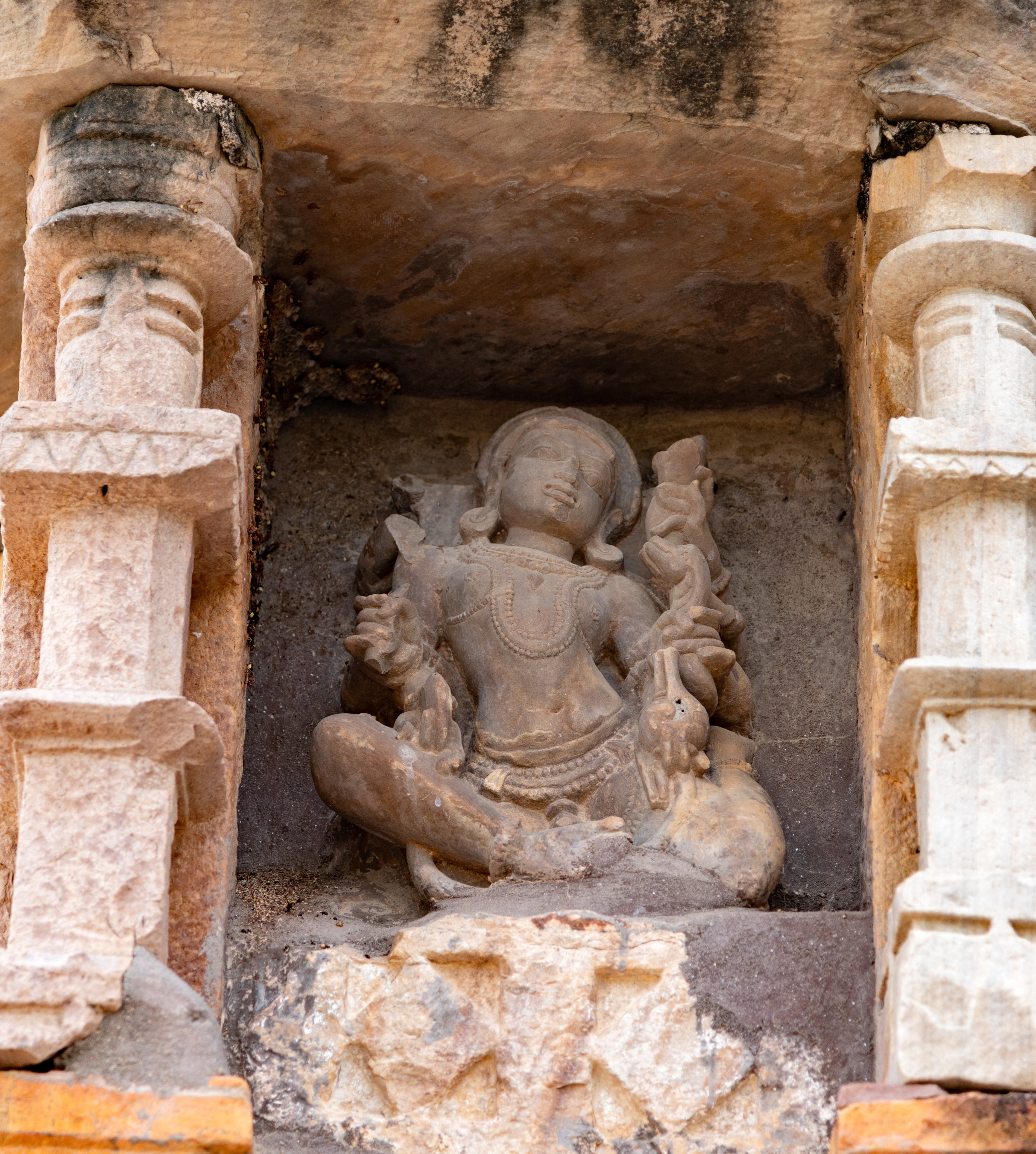
The figure installed in the bhadra (central offset) niche of the lateral wall of the garbhagriha (sanctum sanctorum) is particularly noteworthy. This unidentified deity is depicted as moving through the air, with one leg raised backwards. Although many of the deity’s multiple arms are broken, the intact hands display a shankha (conch shell) and a chakra (discus) in the front right and left hands, an unidentified object in the middle left hand, and a pushpa (flower) in the upper right hand.
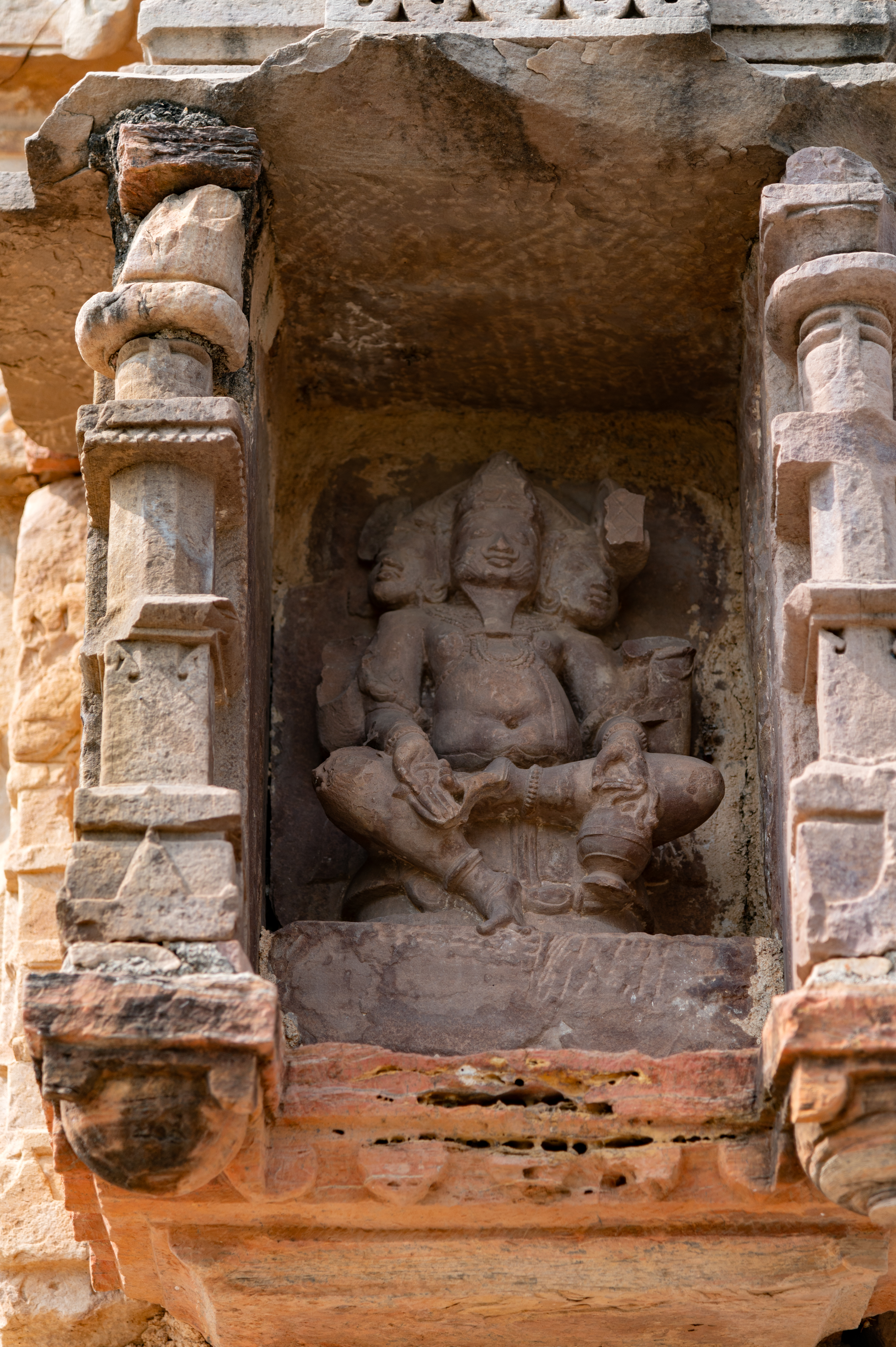
The bhadra (central offset) on the rear wall of the garbhagriha (sanctum sanctorum) is installed with the figure of Brahma. Despite significant damage, the deity is depicted seated on a pedestal, with three faces and four arms. While his upper arms are broken, he holds a kamandalu (water pot) in his lower left hand and makes a varada hasta (boon-giving gesture) with his lower right hand. He is adorned with a jatamukuta (crown of matted hair), a moustache and a beard.
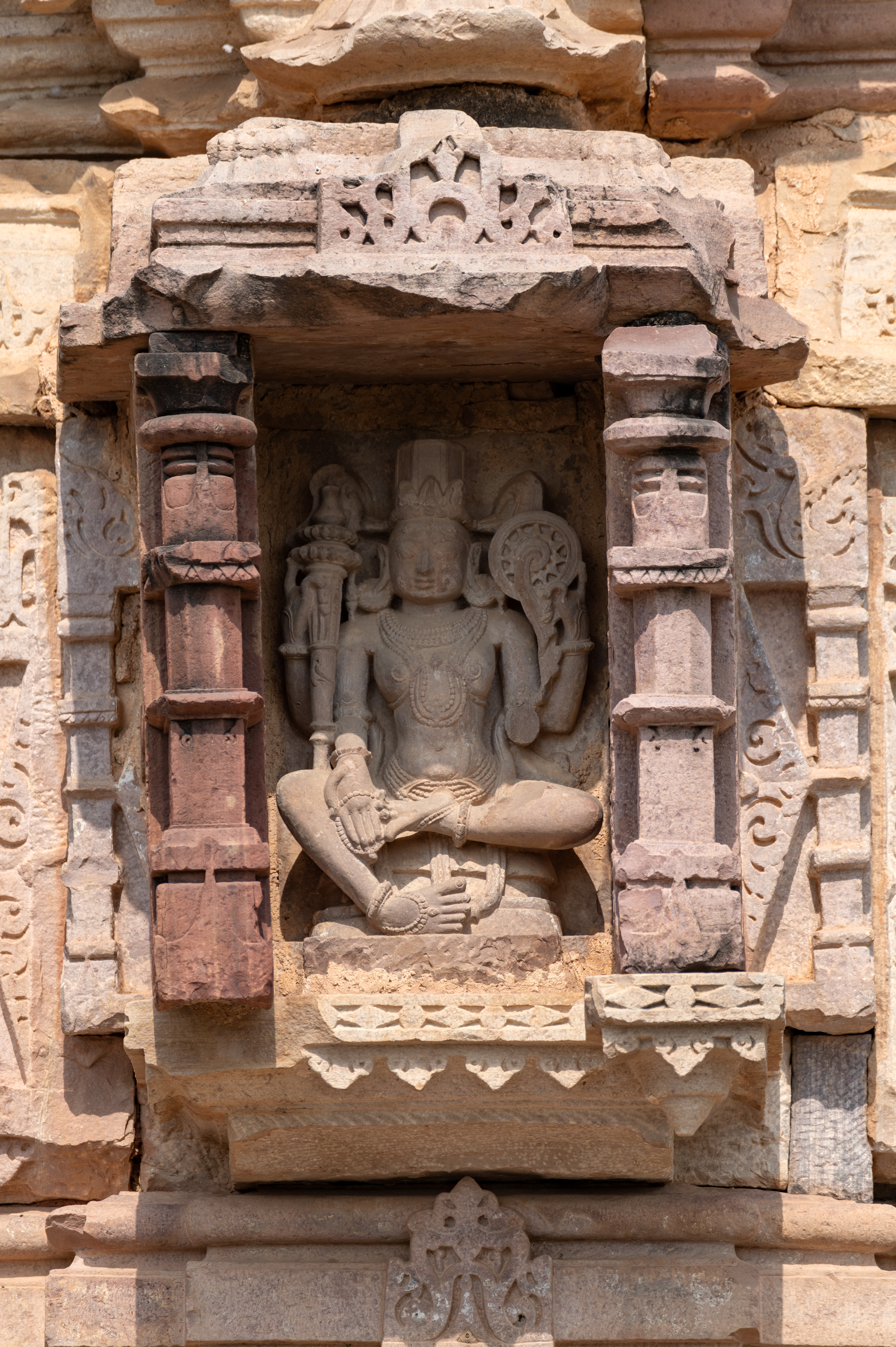
The bhadraratha (central projection) features a seated Vishnu, intricately carved with four arms. Crowned, Vishnu holds a gada (mace) and a chakra (discus) in his upper hands. His lower right hand holds an akshamala (rosary) while also making a varada hasta (boon-giving gesture). Although his lower left hand is broken, Vishnu is adorned with large circular earrings, a broad beaded necklace, a breast band, a girdle, bangles, and anklets.
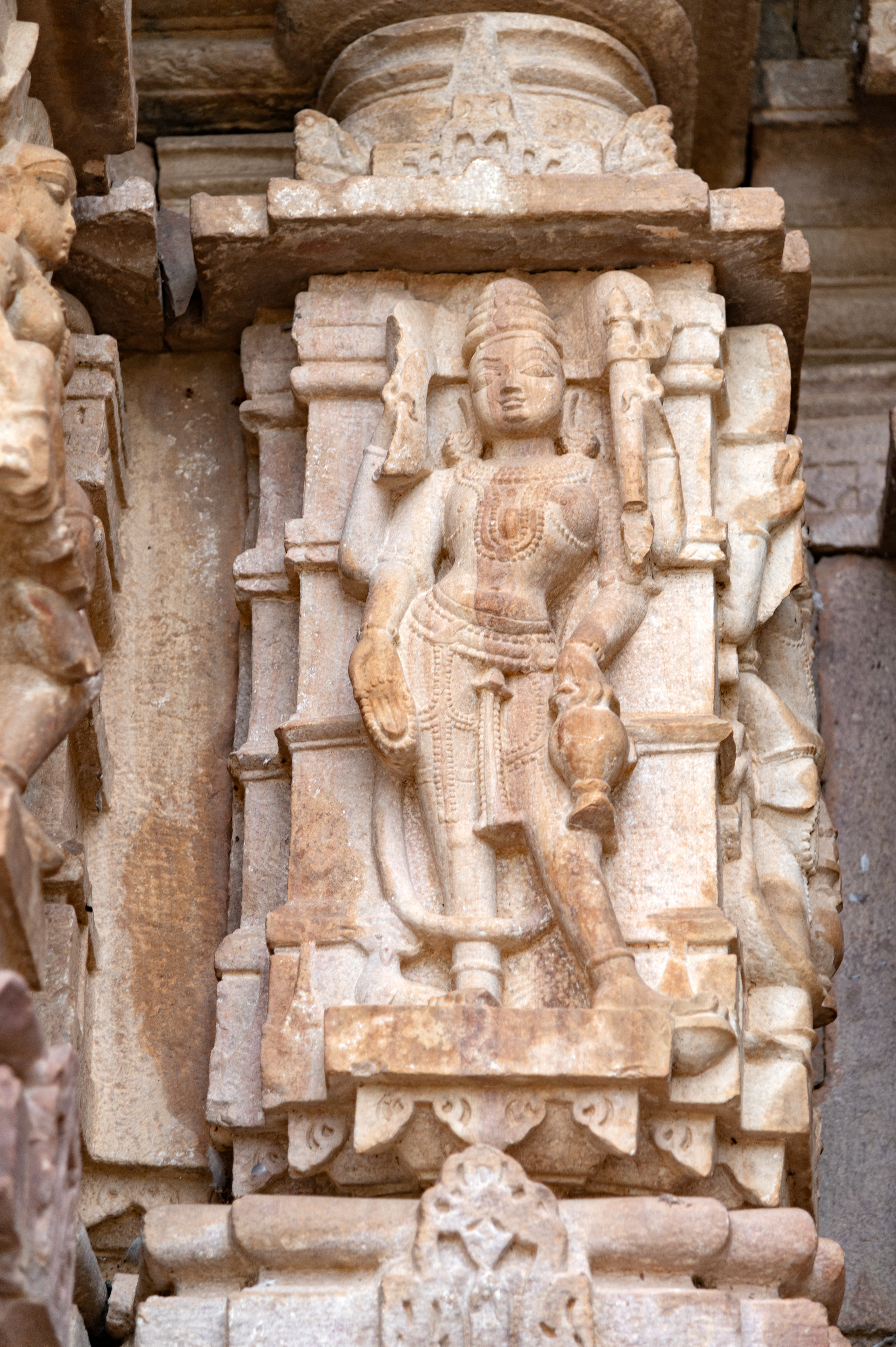
Vayu (one of the deities of the cardinal directions) is depicted with four arms, each holding his respective attributes. Crowned, Vayu is accompanied by his vahana (mount), the antelope, positioned at his feet. In his upper hands, he holds a dhvaja (flag), while his lower left-hand grasps a kamandalu (water pot). His lower right-hand holds a rosary and makes a varada hasta (boon-giving gesture).
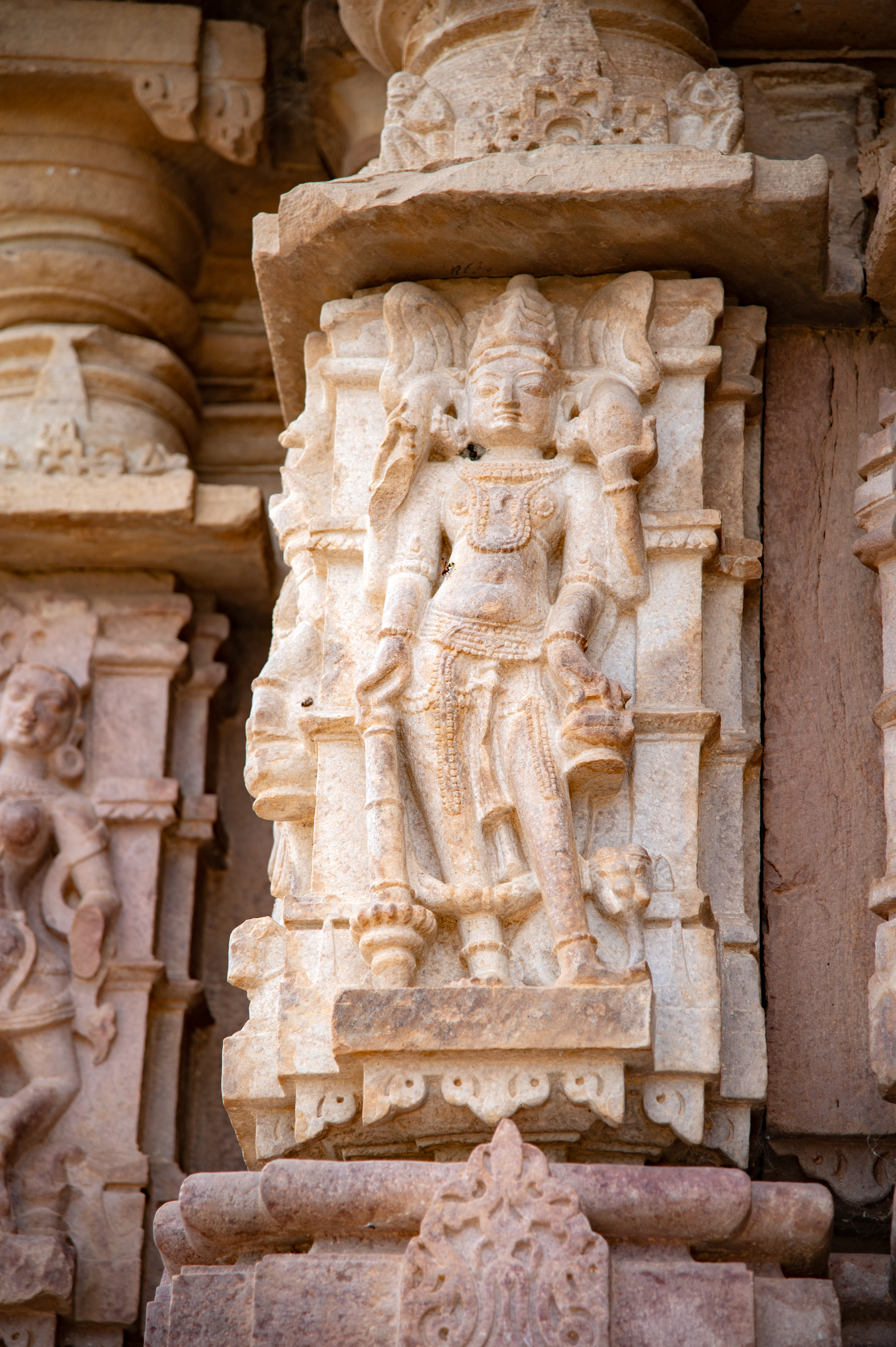
Kubera, the God of wealth, is depicted as four-armed, accompanied by his vahana (mount), the elephant. Crowned and bejewelled, Kubera holds a money bag in his upper hand, a gada (mace) in his lower right hand and a kamandalu (water pot) in his lower left hand.
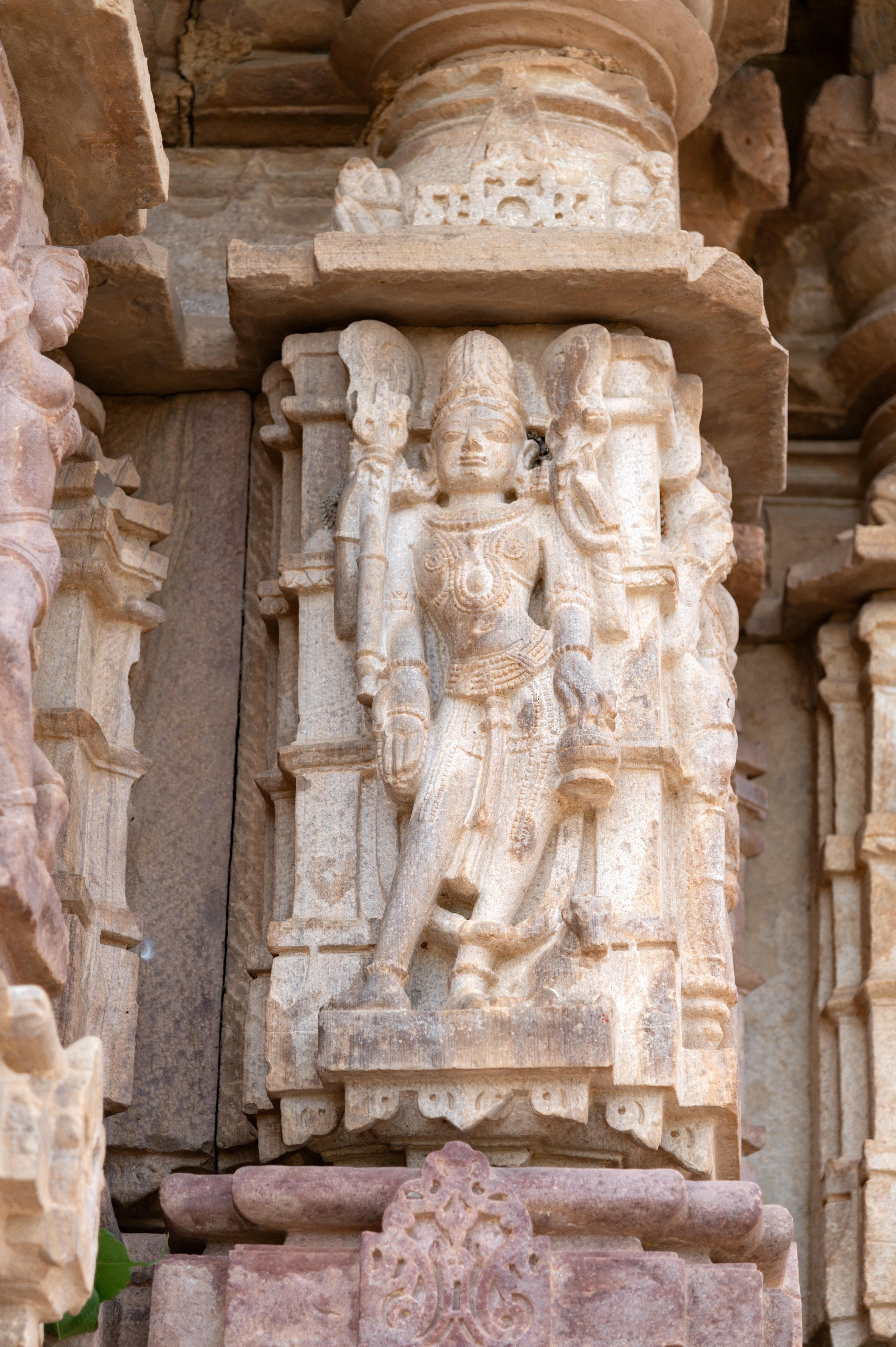
The four-armed Ishana is depicted with a bull, his sacred companion. In his upper right hand, he holds a trishula (trident), while his upper left hand grasps a sarpa (serpent). His lower right hand makes a varada hasta (boon-giving gesture) and holds an akshamala (rosary), while his lower left hand carries a kamandalu (water pot).
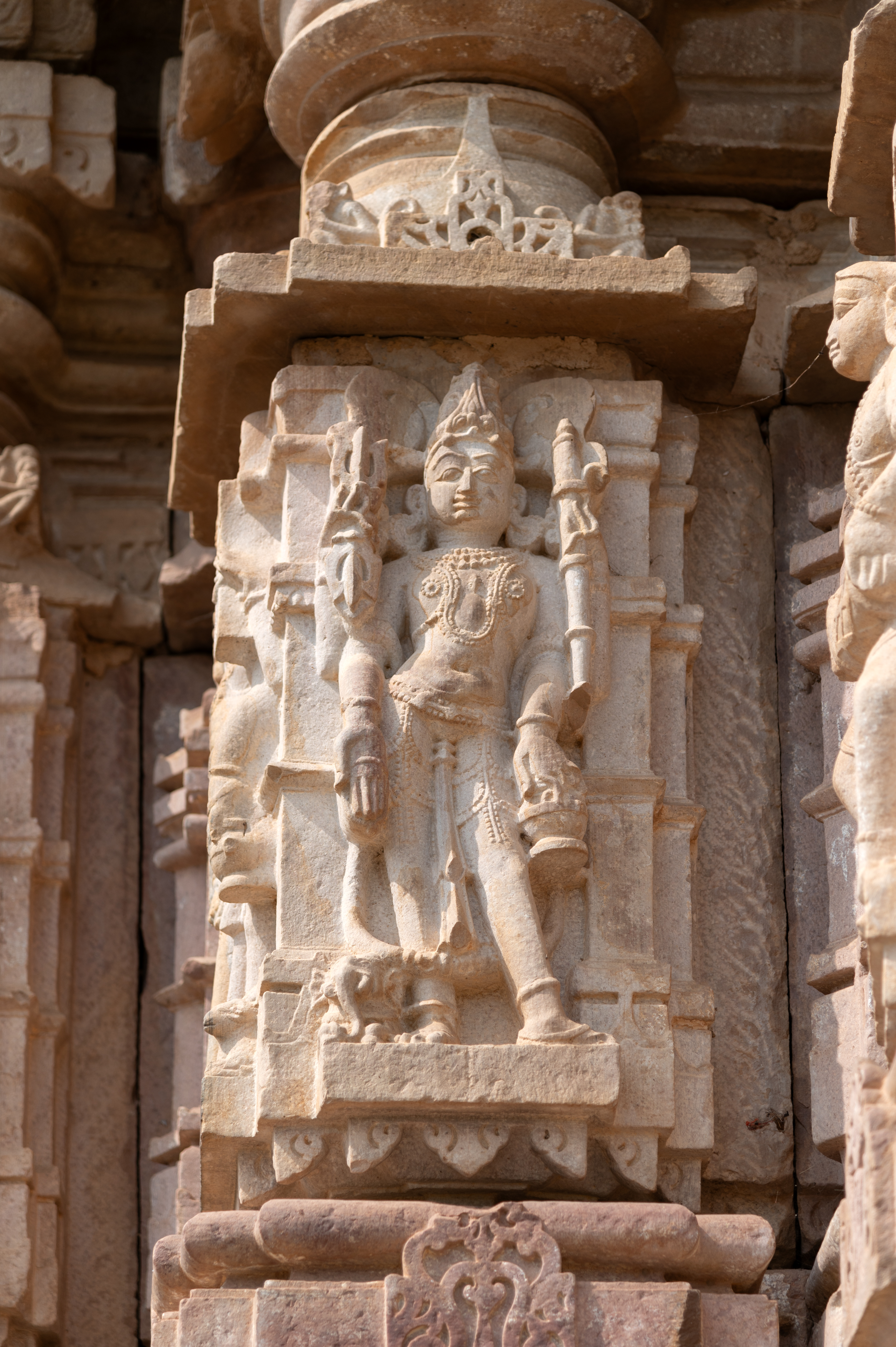
Indra, the God of heaven, is depicted with four arms. In his upper right hand, he holds a vajra (thunderbolt), and in his upper left hand, an ankusha (goad). His lower right hand makes a varada hasta (boon-giving gesture) and holds a rosary, while his lower left hand carries a kamandalu (water pot). Crowned, Indra is accompanied by his mount, the elephant.
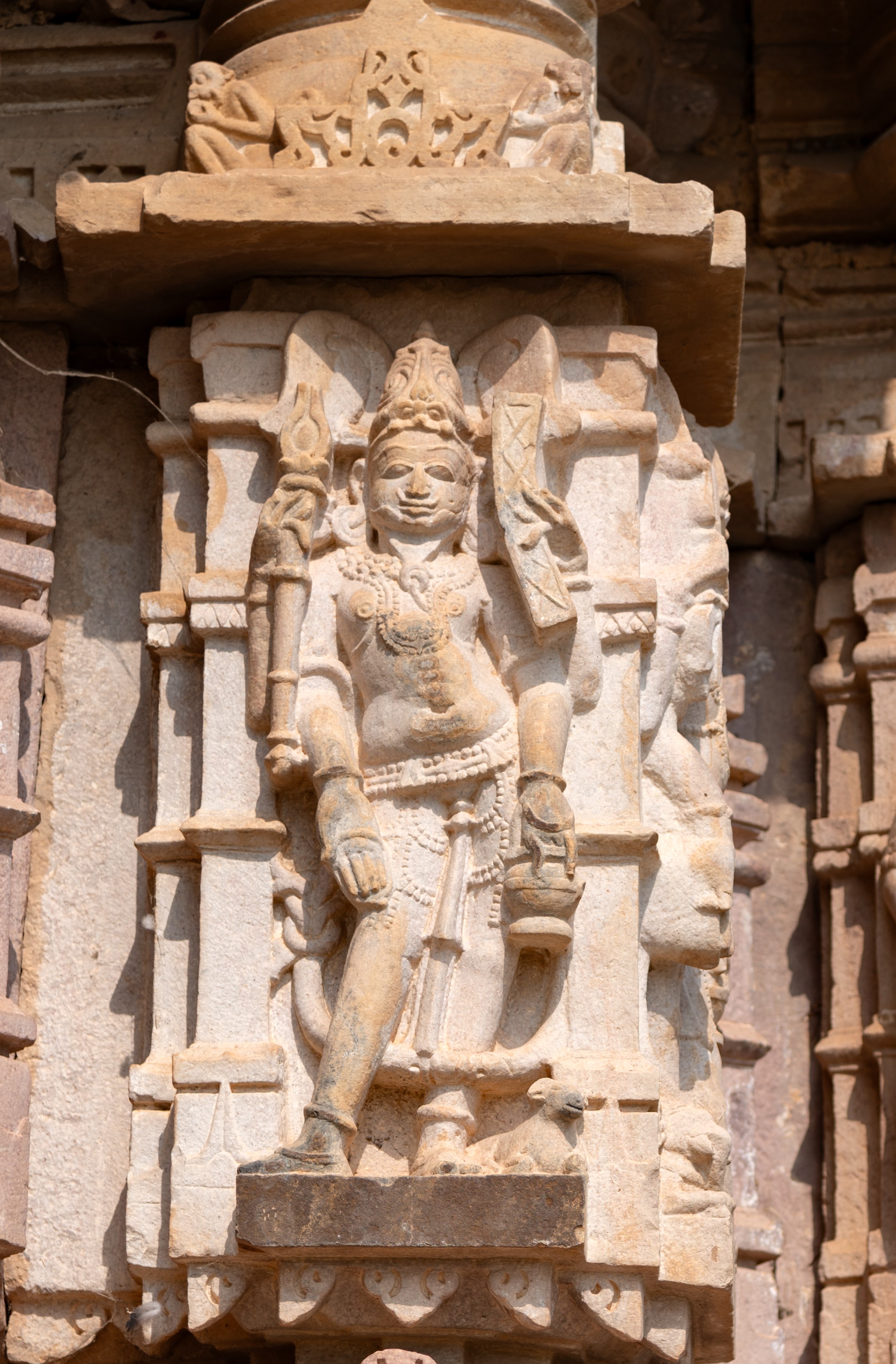
The four-armed Agni is depicted with a shruka (sacrificial ladle) and a pustaka (book) in his upper hands. His lower right hand makes a varada hasta (boon-giving gesture), while his lower left hand holds a kamandalu (water pot). He is adorned with a jatamukuta (crown of matted hair), a moustache, and a long, intricately knotted beard. He is bejewelled and accompanied by his mount, the ram.
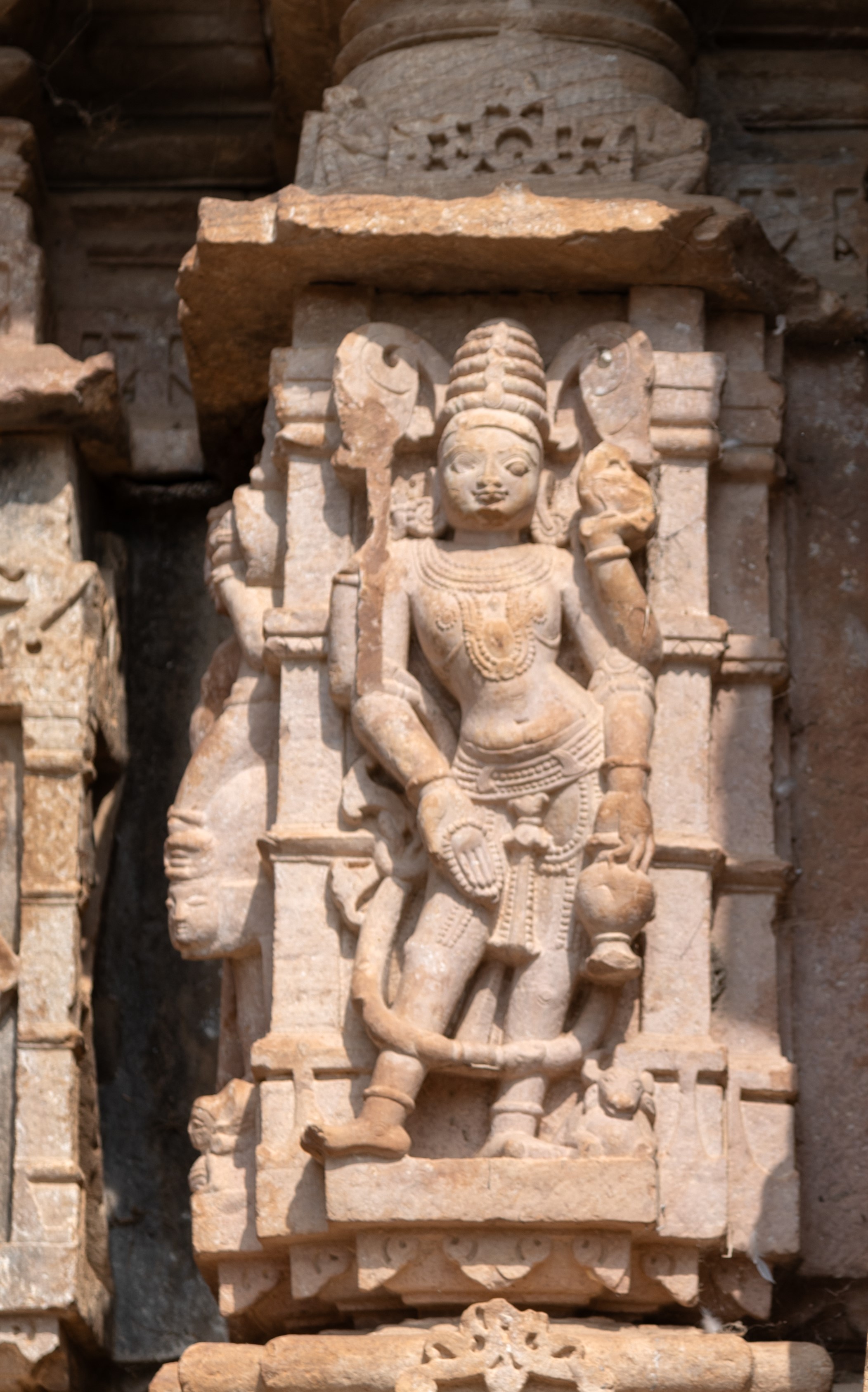
Yama, the guardian of the southern realm, stands with an air of solemnity and grace. Despite the loss of his upper right hand, which once held the danda (rod of justice), his presence remains commanding. In his upper left hand, he holds a rooster. His lower left hand holds a kamandalu (water pot), and his lower right hand holds a rosary and makes a varada hasta (boon-giving gesture). Crowned and adorned with jewels, Yama is accompanied by his mount, the buffalo.
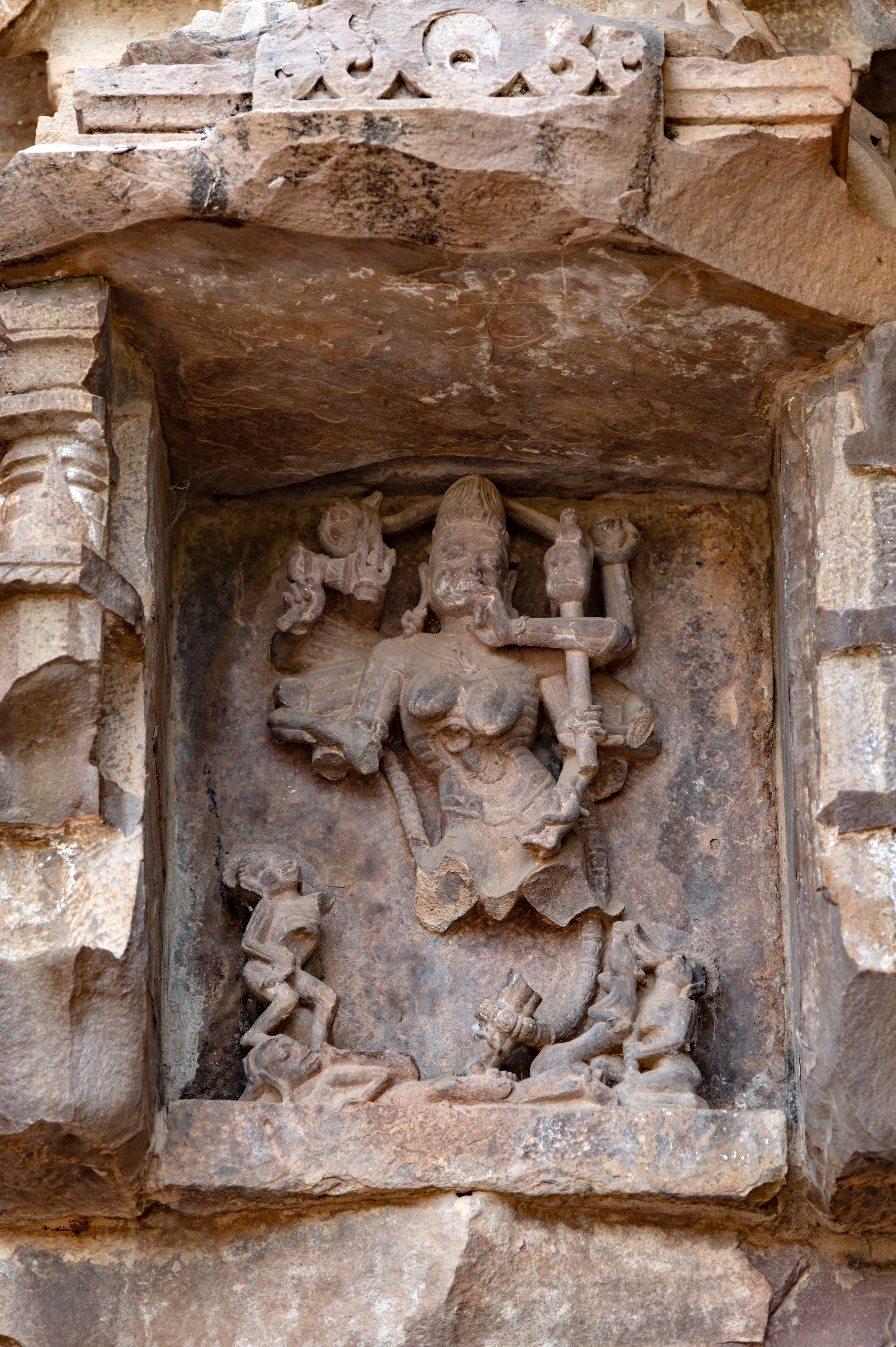
Chamunda stands atop a human form, flanked by two attendants and an animal companion. Though many of her arms are fragmented, her divine attributes are evident. In her upper hands, she carries a sarpa (snake). Her intact right arms carry a damru (drum) and a trishula (trident), while her left hands cradle a khatvanga (staff with a human skull) and a bowl, with the finger of her left hand touching her lips. Chamunda’s portrayal emphasizes her skeletal form, with a cavity in her belly housing a scorpion, symbolizing transformative power. Her lower body is draped modestly with a loin cloth. Adjacent to her, a seated figure grasps a bowl from which he is drinking. It is speculated that one of the goddess’s broken hands may have held a munda (severed human head). The presence of the seated figure suggests the consumption of the blood dripping from the severed head.
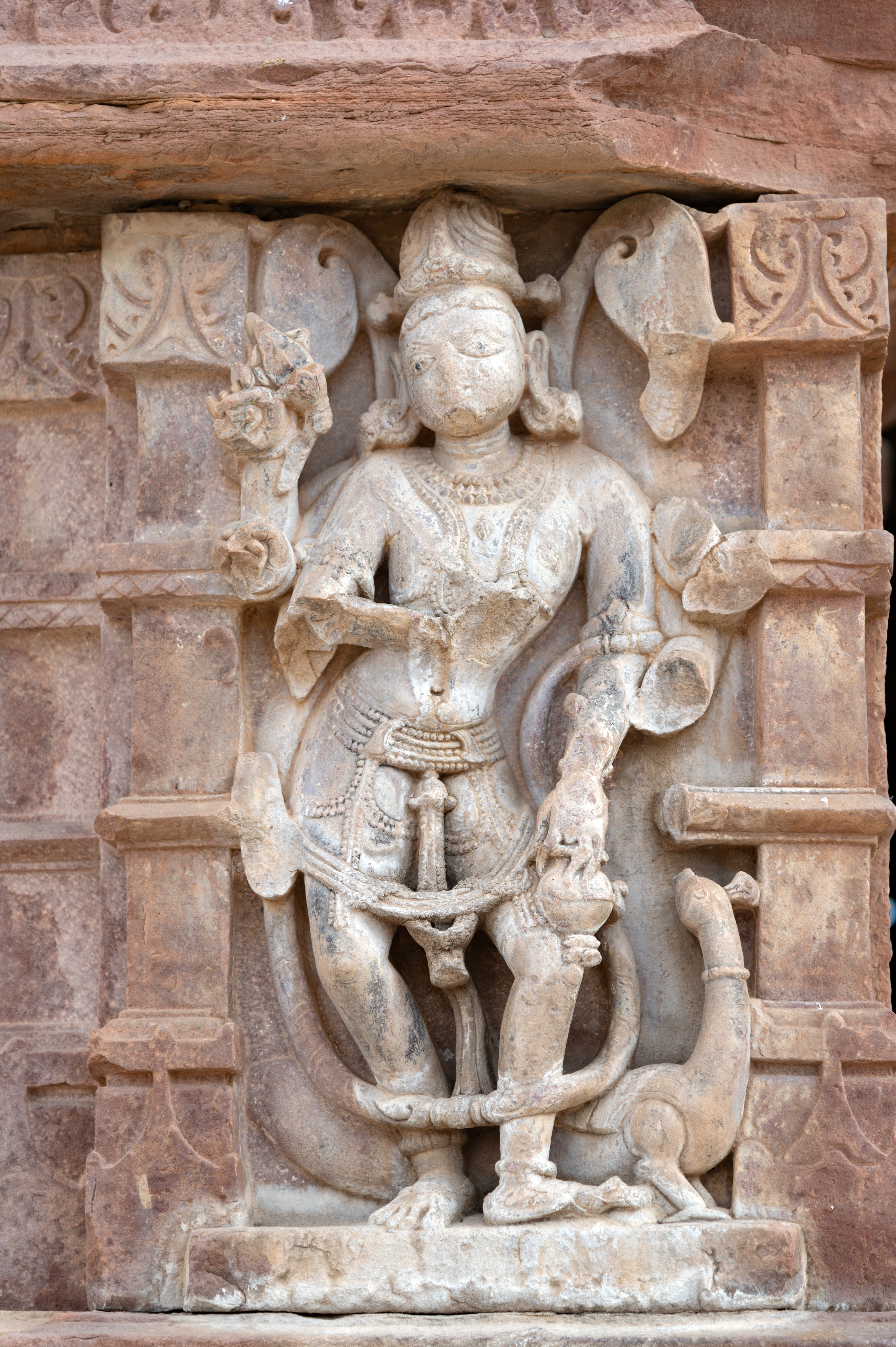
Kartikeya is depicted on the external walls of the mandapa (pillared hall). Though most of his arms are fragmented, he holds a kamandalu (water pot) in his intact hand, symbolizing purity and divinity. He is identifiable by his vahana (mount), the mayura (peacock), depicted below him.

Narasimha is carved on the external wall of the mandapa (pillared hall), though time has weathered its intricate details. This depiction portrays the fourth incarnation of Vishnu, showcasing his formidable aspect with a lion’s visage atop a human form. Despite the erosion of many arms, Narasimha’s attributes are intact. In his upper hands, he holds a chakra (discus) and a shankha (conch shell), symbols of cosmic order and divine sound. His frontal hands are depicted in the act of subduing an asura (demon), although the figure is heavily damaged. He is adorned with jewels and a long garland. Additionally, a figure resembling Varaha is carved at the bottom left.
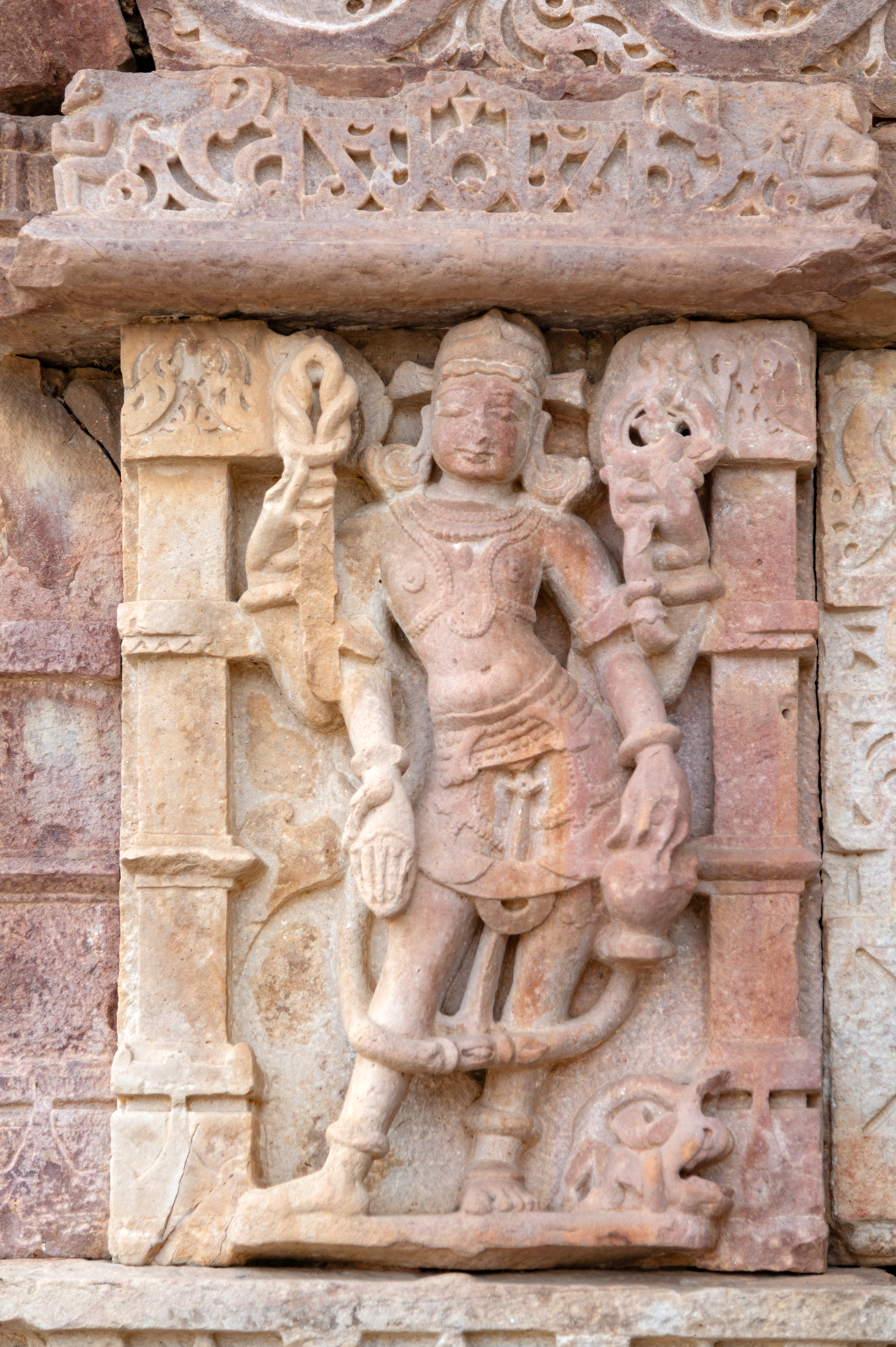
Varuna is depicted alongside his vahana (mount), the makara (crocodile-like mythological sea creature). In his upper right hand, he holds a pasha (noose), symbolizing his control over the cosmic forces. In his upper left hand, he holds a pushpa (flower), representing his connection to the natural world. His lower left hand holds a kamandalu (water pot), signifying purity and sustenance, while his lower right hand extends in varada hasta (boon-giving gesture).
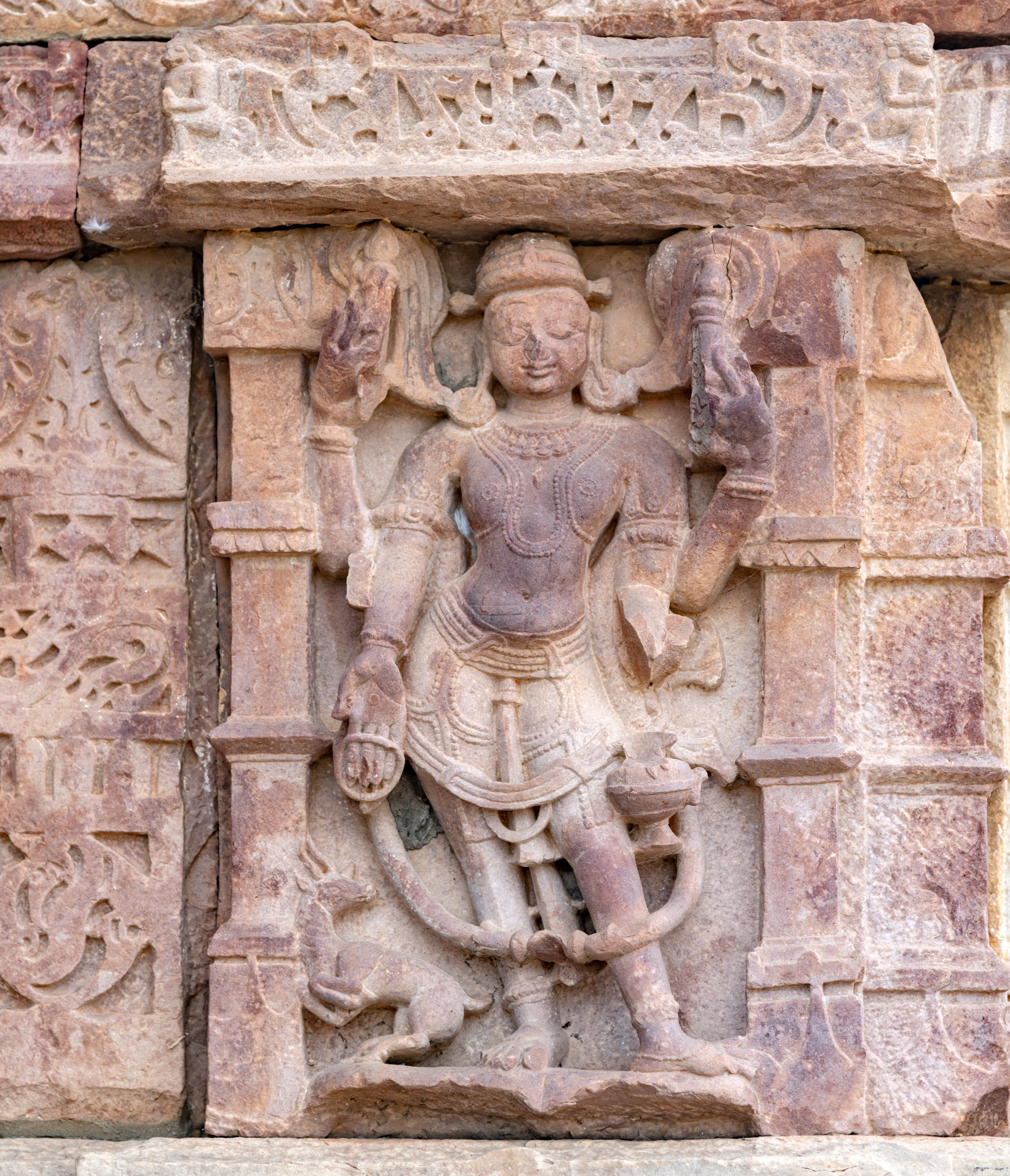
Vayu is depicted standing with a gentle smile. His four arms bear testament to his celestial nature. In his upper hands, he grasps a staff, symbolizing authority and guidance. His lower hands cradle a kamandalu (water pot) and extend in varadaksha (boon-giving gesture with a rosary). At the base, his vahana (mount), the antelope, is depicted in graceful motion, adding to the dynamic energy of the scene.
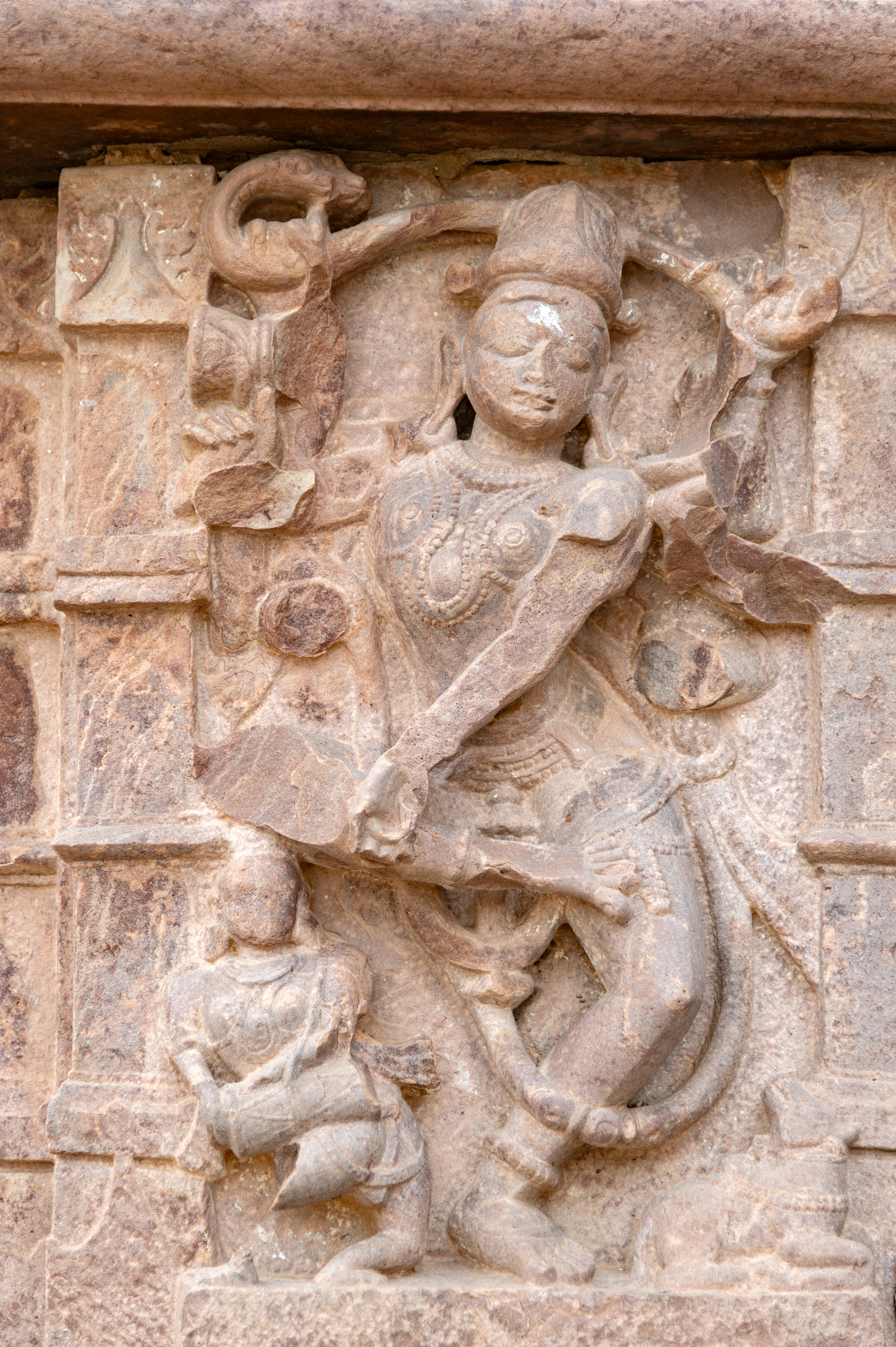
Shiva is depicted in a dance posture. Standing in the urdhvajanu (upraised knee) pose, Shiva is portrayed with multiple arms, each embodying cosmic significance. In his upper hands, he holds a multi-hooded sarpa (serpent) and a damru (drum), symbolizing creation and destruction in the cosmic dance of life. His right and left middle arms are damaged, but some are intact. His lower left hand forms the gajahasta (elephant trunk) gesture. In the lower right corner, a drummer is depicted, accompanying Shiva’s celestial dance with the beats of a drum. Meanwhile, at the opposite corner, Shiva’s mount, Nandi, is portrayed in a seated posture.

Harihara is depicted as a synthesis of Shiva and Vishnu. In this form, Shiva occupies the right half, adorned with a jatamukuta (crown of matted hair). Vishnu occupies the left half, crowned with a kiritamukuta (a cylindrical crown associated with Vaishnava iconography). In his upper right hand, Harihara wields a trishula (trident), symbolizing Shiva’s power, while his lower left arm holds a shankha (conch), symbolizing Vishnu’s presence. Nandi, Shiva’s mount, is carved at the bottom right, and a kalasha (pitcher) adorned with vegetal motifs is depicted at the bottom left, symbolizing abundance.
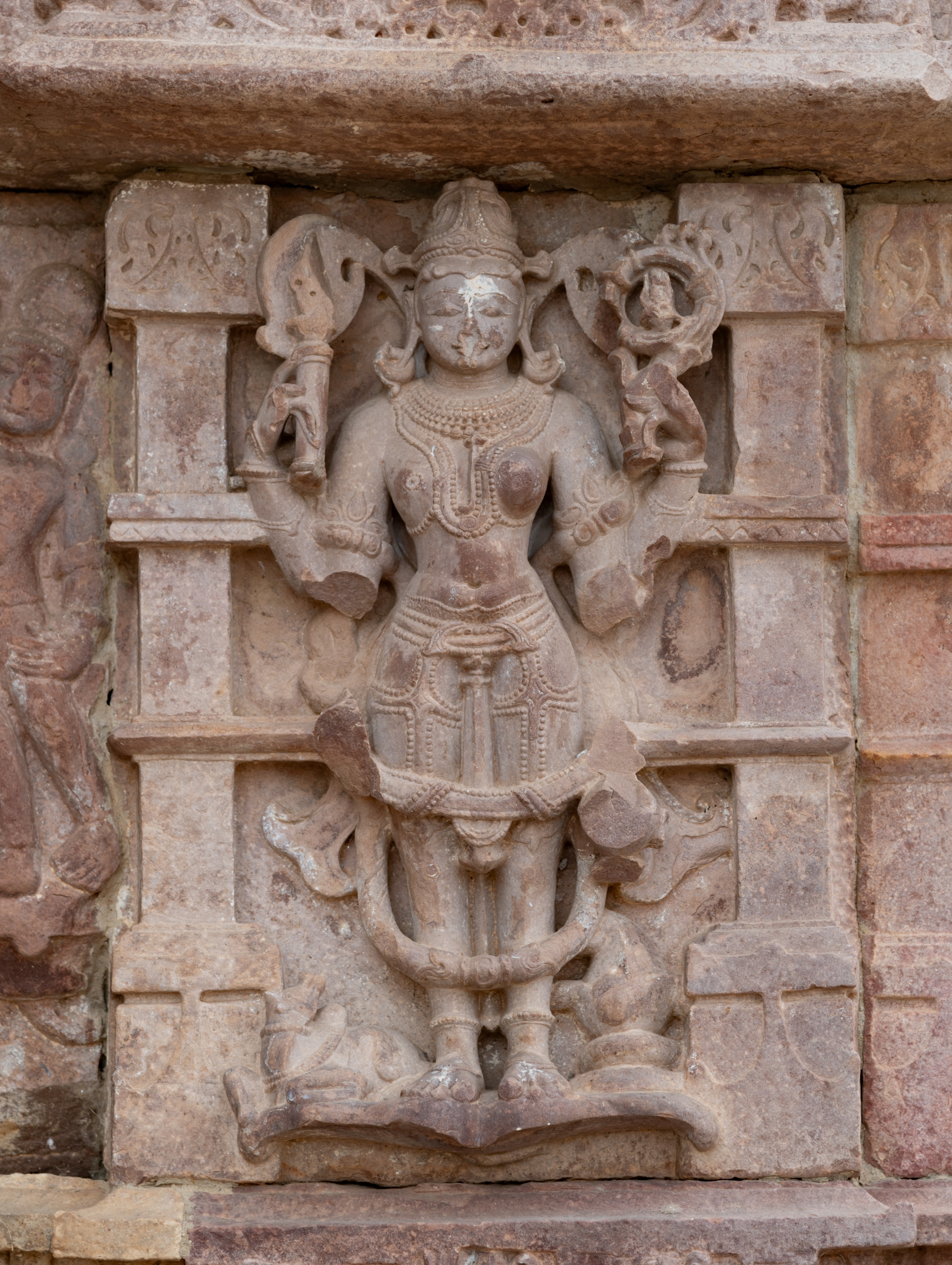
A syncretic representation adorns the kakshasana (seat backs) niche in the form of Ardhanareshwar, embodying the divine union of Shiva and Uma. Shiva’s right half and Uma’s left half seamlessly blend into a single divine form, symbolizing the inseparable nature of masculine and feminine energies. While the figure originally had four arms, only the upper two remain intact. Shiva’s side wields a pointed weapon, signifying his power, while Uma’s side holds a pushpa (flower), representing her nurturing aspect. At the bottom, Nandi, Shiva’s mount, accompanies his side, while Uma’s side features a kalasha (pitcher) adorned with verdant vegetation, symbolizing fertility and abundance. It is significant because both the syncretic images of Harihara and Uma-Maheshvara connect Vishnu and Uma with vegetal growth, symbolizing prakriti (nature), while Shiva represents purusha (essence).
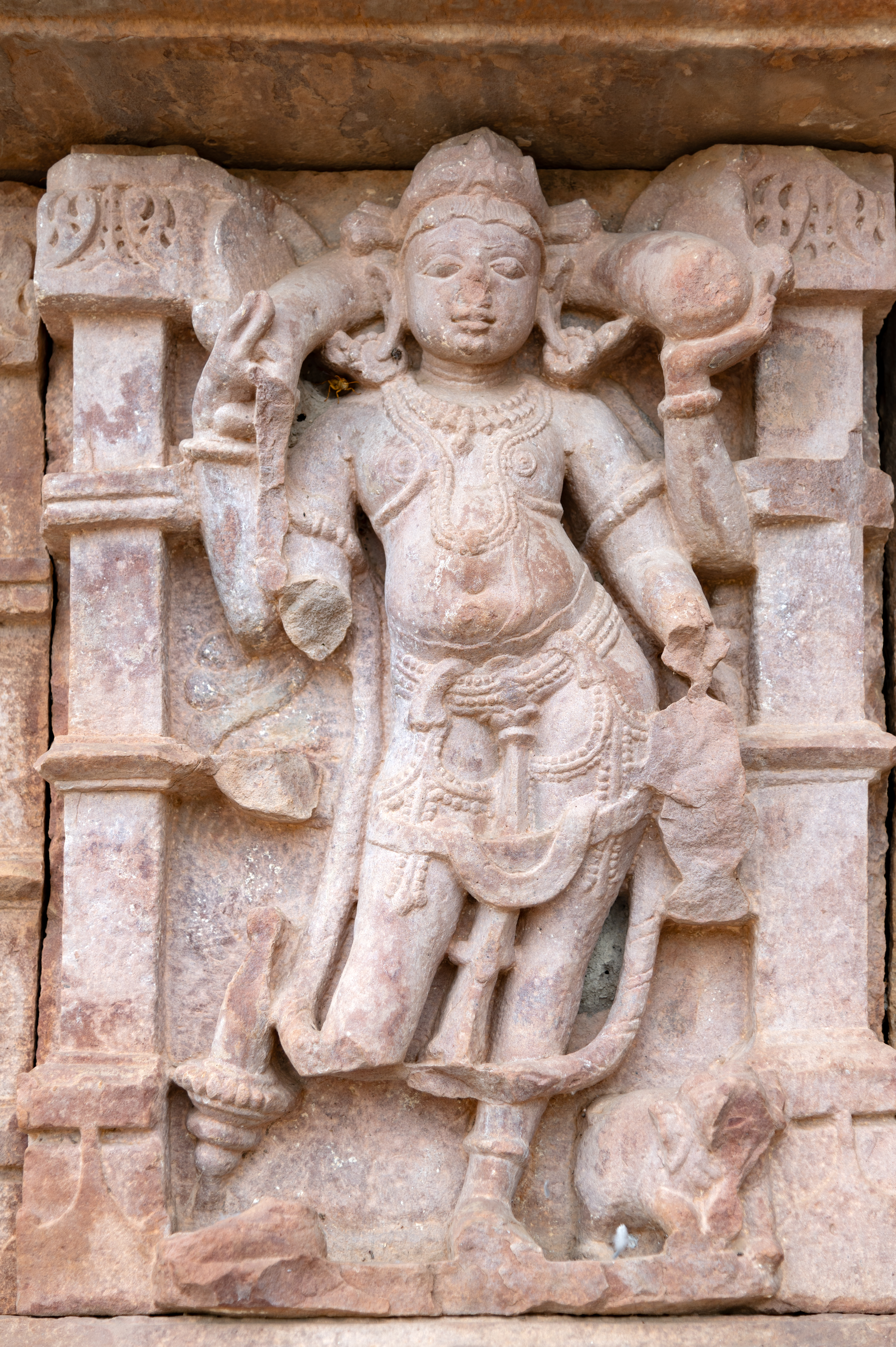
Kubera, accompanied by his mount, the elephant, is depicted with four arms. In his upper arms, he holds a symbol of wealth and abundance —a money bag. Though his lower arms are damaged, it is evident that he once wielded a gada (mace) in his lower right hand and a kamandalu (water pot) in his lower left hand.
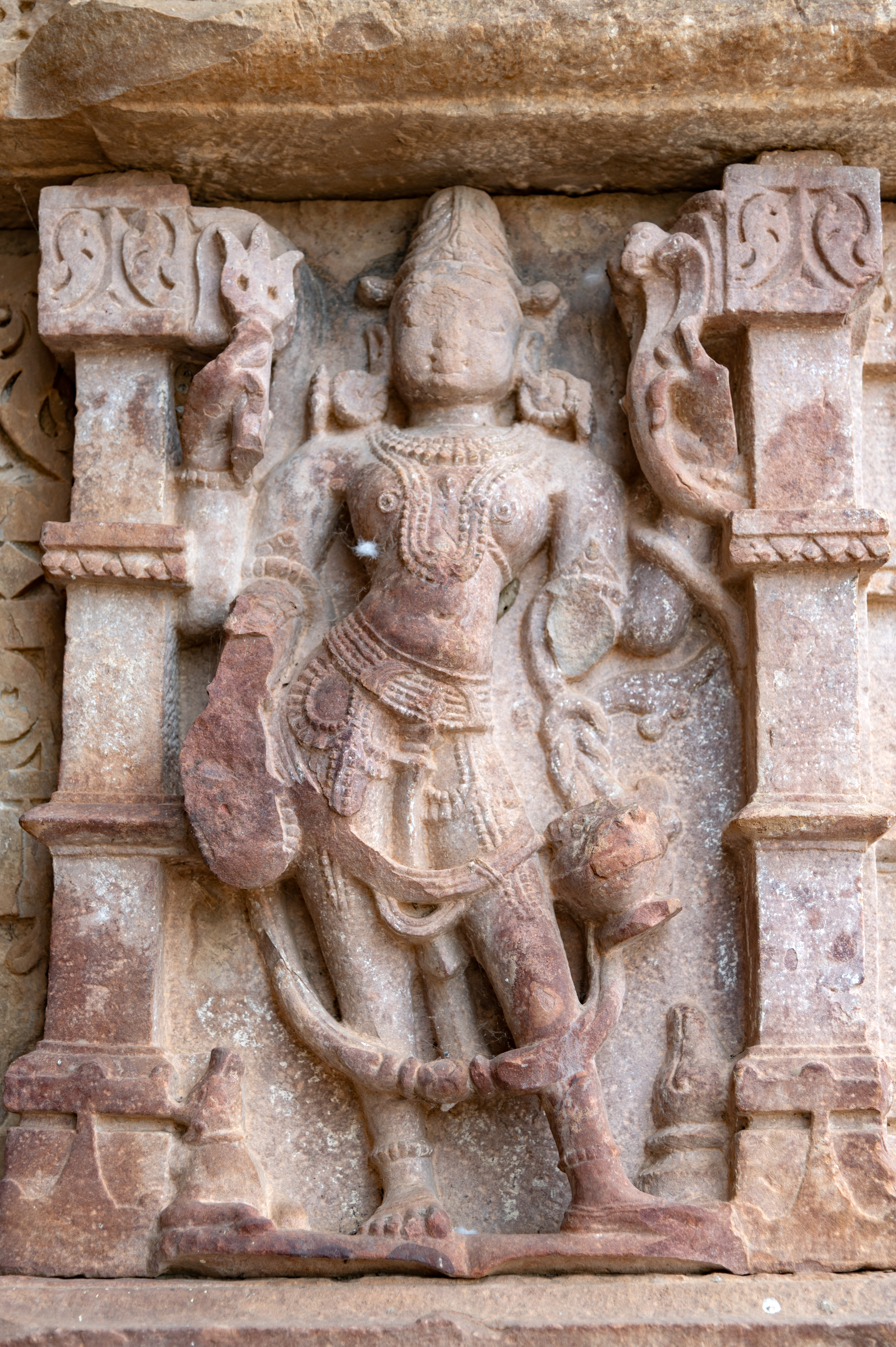
Ishana is depicted with four arms, holding a trishula (trident) and sarpa (snake) in his upper hand. He is holding a kamandalu (water pot) and varadaksha in his lower hands. He wears a jatamukuta (crown of matted hair) and is adorned with jewels. At the bottom right, his mount, the bull, is carved.
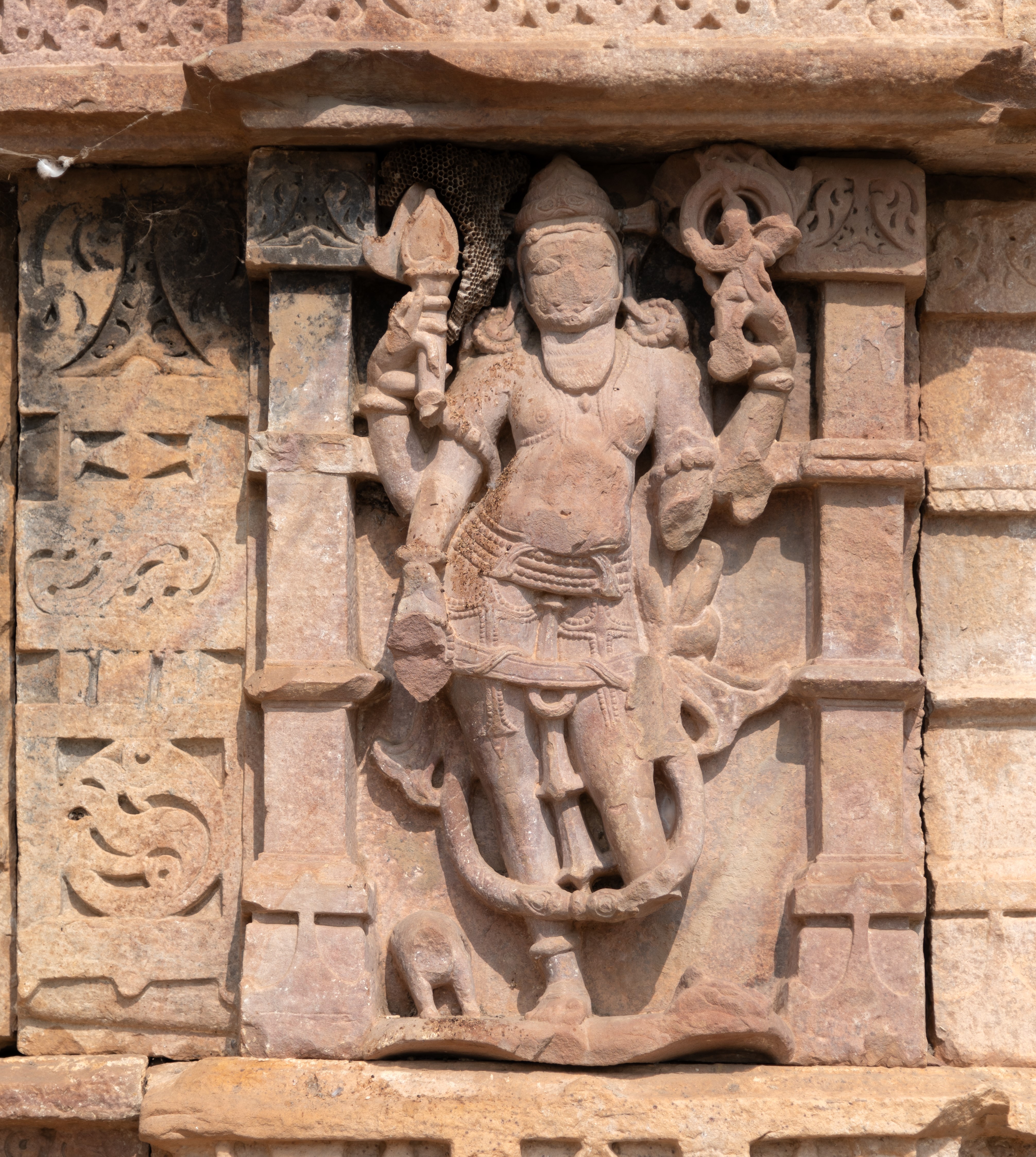
Agni, the guardian of the southeast direction, is depicted holding a pointed spoon and a pushpa (flower) in his upper hands. His lower hands and the face of his vahana (mount) are broken. He wears a jatamukuta (crown of matted hair) and has a beard.
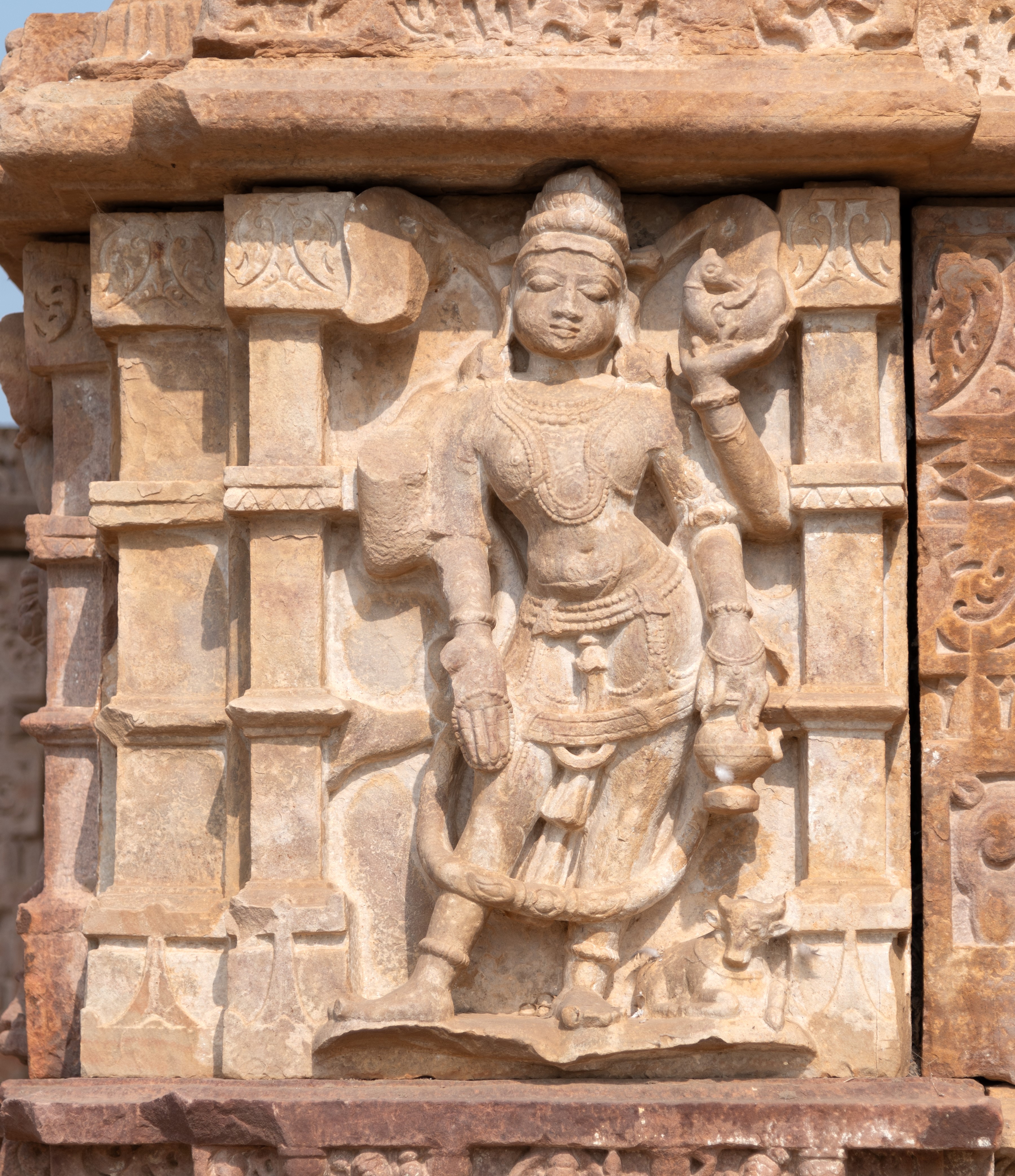
Yama, the God of justice and guardian of the south direction, is depicted holding a rooster and a kamandalu (water pot). One of his hands is in varada hasta (boon-giving gesture). He is adorned with jewels and wears a long garland. At the bottom left is a carving of a buffalo.
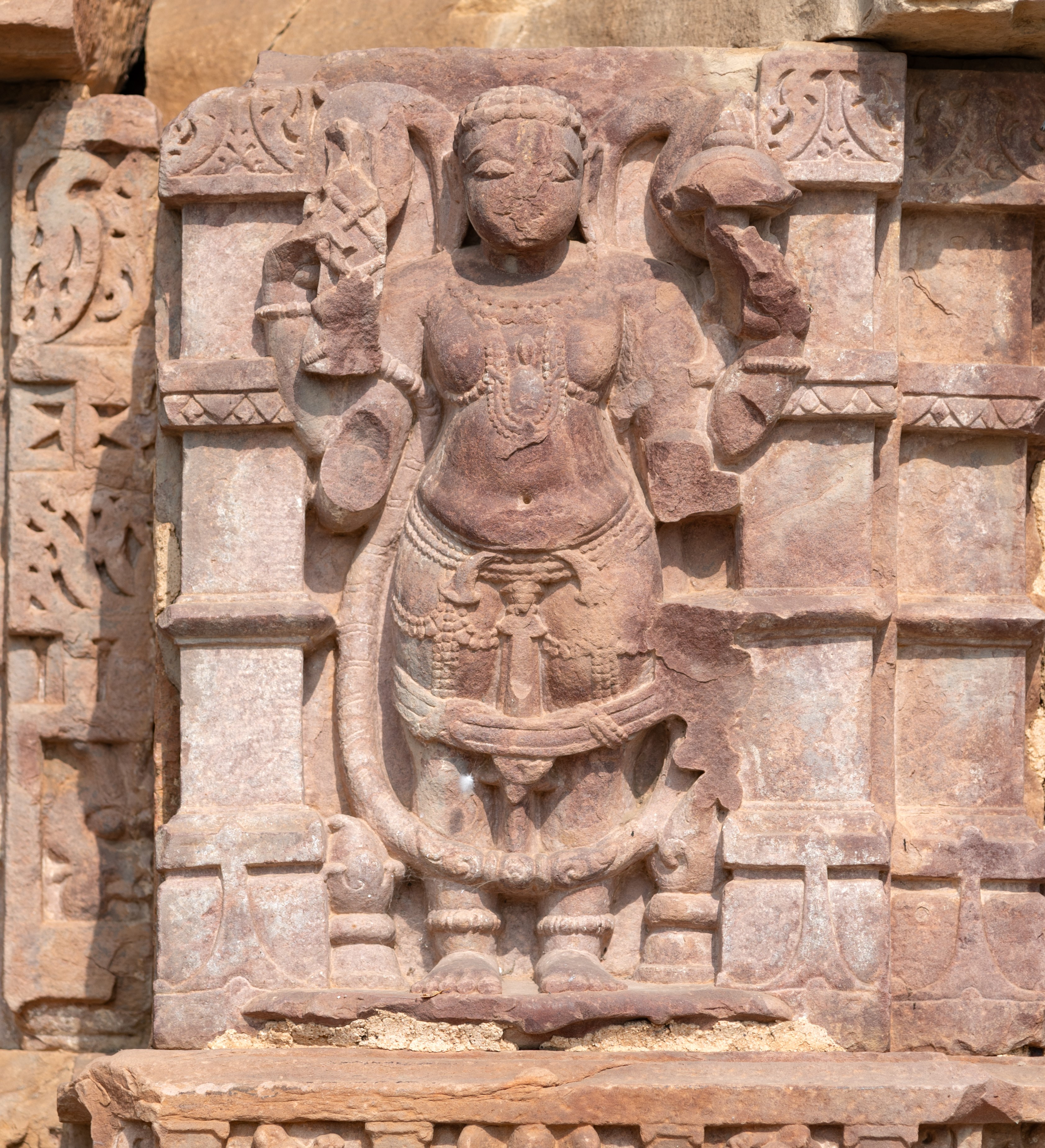
On the kakshasana (seat backs), the depiction of Vamana, an avatar of Vishnu, stands prominently. Vamana is portrayed with four arms, although two are damaged. In his upper right hand, he holds a pustaka (book). This attribute holds significant symbolism, as Vishnu in his Vamana avatar assumes the form of a Brahmin, embodying the essence of divine wisdom contained within the Vedas.
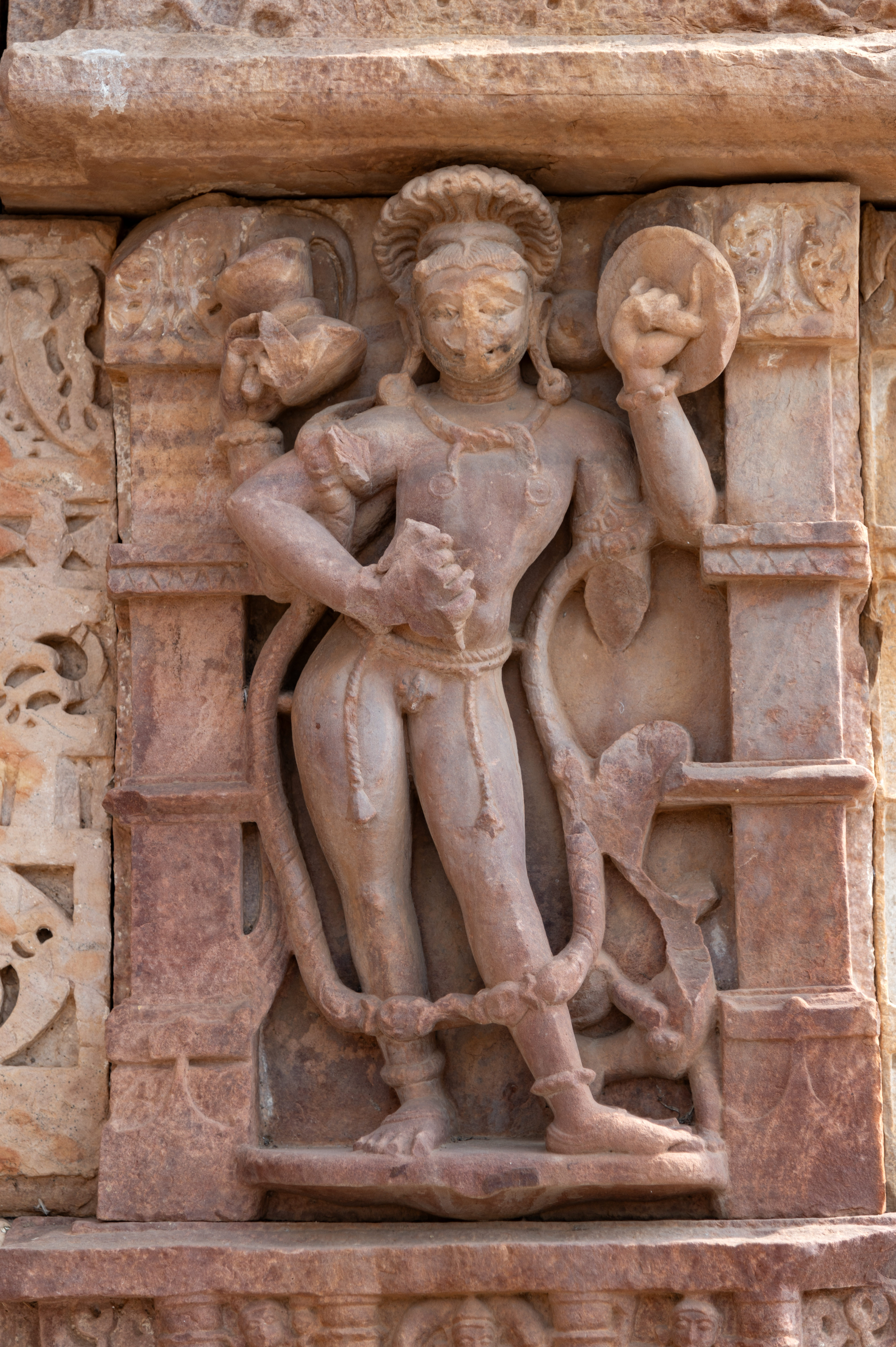
A figure of Nirutti stands prominently with a noticeable phallus, symbolizing his association with fertility and vitality. In his hands, Nirutti holds a damru (drum), a khetaka (shield), and a musala (pestle). At the bottom left, a broken animal is depicted. Nirutti’s distinctive high-raised hairdo adds to his unique presence, while his adorned appearance with jewels and a long garland underscores his divine status.
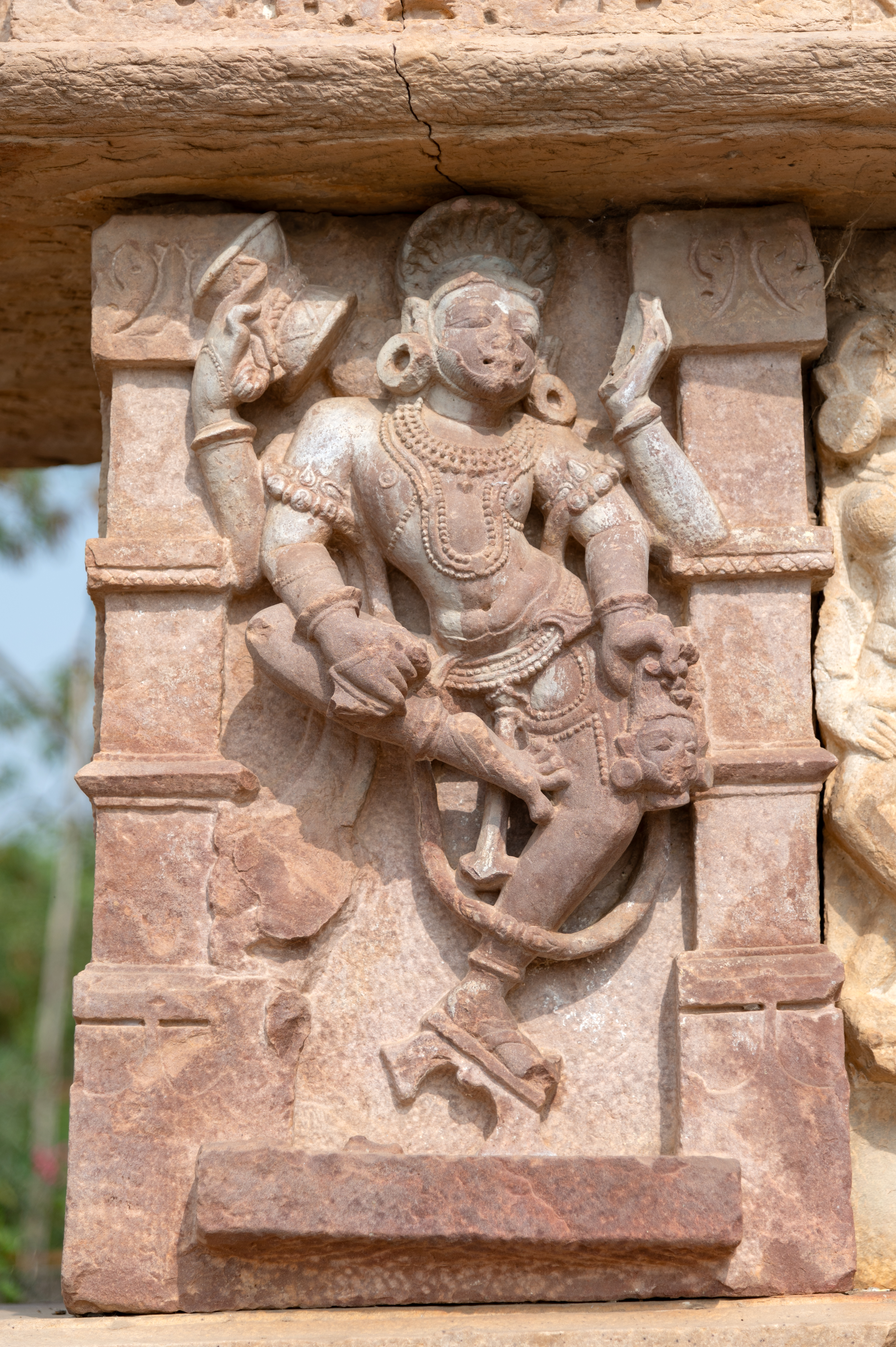
Bhairava is portrayed dancing, his four arms moving in a divine rhythm. Notably, Bhairava wears unique footwear with a distinct heel. His left foot, adorned with a sandal, rests firmly on the ground, while his right foot is raised inward, adding dynamism to his celestial dance. In his upper hands, Bhairava holds a damru (drum) and a bowl. His lower left hand holds a severed human head, while his lower right hand grasps an object resembling a musala (pestle). His appearance is marked by a highly raised hairstyle, a moustache and a flowing beard.
[2] Mankad, ed., Aparājitaprchhā of Bhuvanadeva, 213, 9–16.
Shastri, T. Ganapati, ed. Samarāṅgaṇasūtradhāra. of Bhojadeva. Baroda: Oriental Institute, 1966.
Mankad, P.A, ed. Aparājitaprchhā of Bhuvanadeva. Baroda: Oriental Institute, 1950.






















